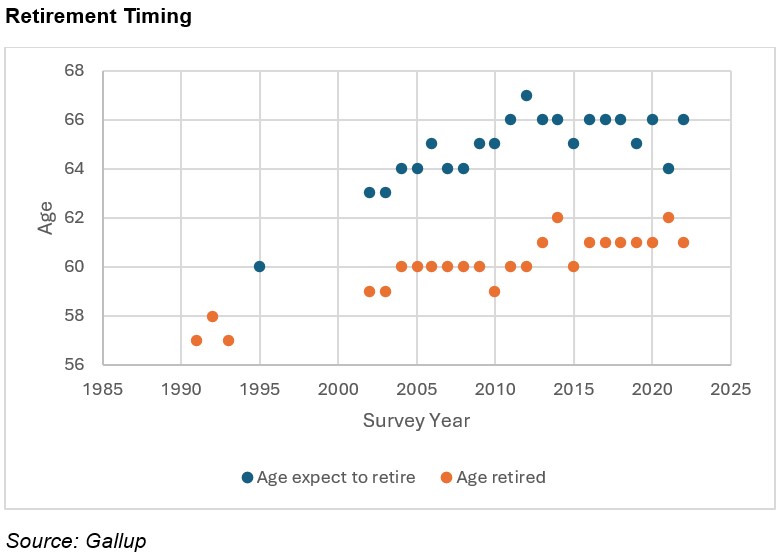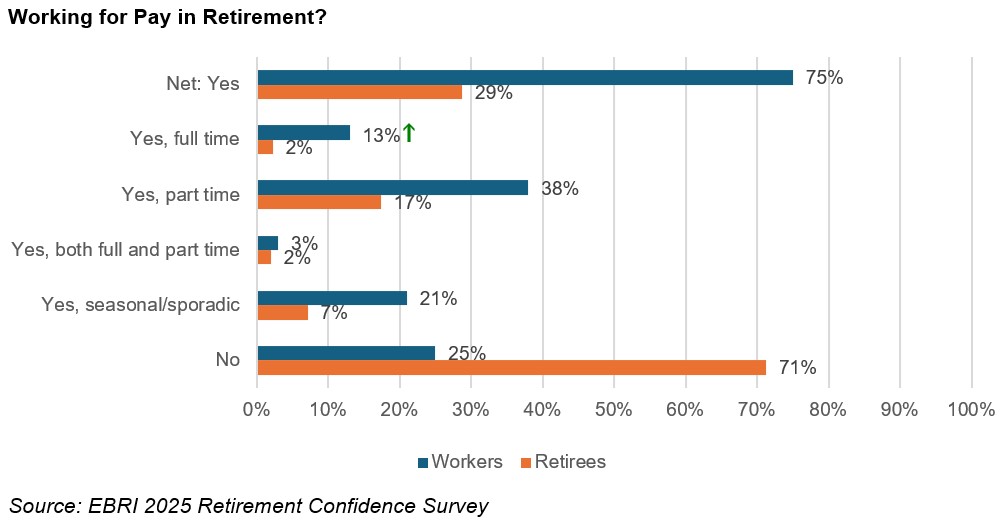What You Expect in Retirement vs What You Get: Where Reality Can Surprise You
A financial planner explores how your expectations for retirement can greatly differ from reality — and how you can plan for that.


When and how we each eventually retire can have significant implications on our financial situations during retirement.
Here, I’ll review three key gaps that exist when it comes to retirement expectations, primarily leveraging data from EBRI’s 2025 Retirement Confidence Survey (RCS):
- People tend to retire early (about three years, on average)
- Retirement tends to happen more suddenly than expected (more like a waterfall than a glide path)
- The actual odds of working during retirement are a lot lower than expected (75% expect to work, but only about 30% do so)
Collectively, these three gaps can have significant (negative) financial implications on retirement outcomes if they aren’t considered; therefore, it’s important for companies and financial planners to educate workers about these gaps to help them plan accordingly.
From just $107.88 $24.99 for Kiplinger Personal Finance
Become a smarter, better informed investor. Subscribe from just $107.88 $24.99, plus get up to 4 Special Issues

Sign up for Kiplinger’s Free Newsletters
Profit and prosper with the best of expert advice on investing, taxes, retirement, personal finance and more - straight to your e-mail.
Profit and prosper with the best of expert advice - straight to your e-mail.
The Kiplinger Building Wealth program handpicks financial advisers and business owners from around the world to share retirement, estate planning and tax strategies to preserve and grow your wealth. These experts, who never pay for inclusion on the site, include professional wealth managers, fiduciary financial planners, CPAs and lawyers. Most of them have certifications including CFP®, ChFC®, IAR, AIF®, CDFA® and more, and their stellar records can be checked through the SEC or FINRA.
Retiring early is the norm
One of the most important assumptions in a retirement plan is the age of retirement. A few extra years of work can do wonders in terms of closing any kind of savings gaps.
Working longer gives someone an extra year to save, an extra year for those savings to grow, one less year of retirement income to fund and one additional year to delay claiming Social Security. I’ve often described delayed retirement as the “silver bullet” when it comes to improving retirement outcomes.
Unfortunately, there has been a relatively persistent gap between actual and expected retirement ages for the past 30-plus years, where people tend to retire earlier than expected (on average).
For example, historically about 50% of retirees retire on time, about 45% retire earlier than expected, and about 5% retire later than expected.
The median expected retirement age is 65, which has drifted slightly upward over time, but the median actual retirement age is closer to 62.
We can see the evolution of actual and expected retirement ages leveraging data from Gallup, an effect that is very consistent with some research I’ve worked on leveraging data from the Health and Retirement Study.

While there was a noticeable bump in retirement timing differences in the latest RCS, where only 40% noted retiring earlier in the 2025 RCS, vs 49% in the 2024 version, it’s too early to say if this is part of a new trend or a relatively temporary effect.
The gap clearly persists, though, where most people retire before they expect to do so (or on time), while relatively few (only 6%) retire later than expected.
It’s important to note that many of the reasons people retire early are not related to choice.
For example, based on the 2025 RCS, while 44% of retirees note retiring early because they could afford to do so, 66% of the reasons cited were out of the respondent’s control (each respondent could select multiple options), such as company downsizing or health issues.
In other words, retiring early for many (or most) of those who have to do so is less of a choice than something that just happens (that can’t easily be prepared for).
Retirement is more like a waterfall than a glide path
Most people expect a smooth transition into retirement.
For example, 50% of workers expect a gradual transition or reduction of hours leading to a full-time stop in retirement (or glide path).
In reality, though, 73% of retirees report a full-time stop, while only 19% report more of a glide path. These findings suggest retirement could be a lot more abrupt than most workers are expecting today.
While part of this effect is likely related to the involuntary situations prompting when people retire (i.e., they retire early), experiencing an abrupt retirement may leave the individual with fewer options should they want (or need) to continue working.
Working in retirement: Not so much a thing
While it’s true that labor force participation rates have been on the rise among older Americans over the last few decades, the actual percentage of working retirees is significantly lower than those who expected to do so.
We can see this effect by looking at data from the RCS, which asks current workers if they think they will work for pay after they retire and if they have worked for pay since they retired. The distribution of responses is included below.

We can see that while 75% of workers expect to work for pay in retirement, only about 30% have done so, primarily on a part-time (17%) or a seasonal/sporadic (7%) basis. Only 2% of retirees report working full time in retirement.
Among those who note working for pay, the number one cited reason was wanting to stay active and involved (89% of respondents), followed by enjoying working (88% of respondents).
Looking for expert tips to grow and preserve your wealth? Sign up for Building Wealth, our free, twice-weekly newsletter.
Only 40% of those working report doing so to make ends meet, although 73% report working for pay to make money to buy extra things.
Helping investors expect the expected
A retirement income plan is only as good as its assumptions. There are notable, persistent gaps that exist between worker expectations and the outcomes experienced by retirees that need to be incorporated into any kind of retirement income projection, especially since most of the gaps could negatively affect the retirement outcome of workers.
Educating workers on these points and helping set reasonable expectations is key.
For example, a client may say they plan on working until age 67, but educating them about the likelihood of early retirement and using age 65 in financial planning is probably a more reasonable assumption.
Additionally, a client may be confident he or she will work in retirement to supplement any kind of savings shortfall, but this is a lot less likely to happen in reality.
Therefore, understanding what’s actually expected in retirement can help clients prepare for what they might not expect.
All investing involves risk. The views expressed herein are those of PGIM investment professionals at the time the comments were made and may not be reflective of their current opinions and are subject to change without notice. Neither the information contained herein nor any opinion expressed shall be construed to constitute an offer to sell or a solicitation to buy any security.
PGIM DC Solutions LLC ("PGIM DC Solutions") is an SEC-registered investment adviser, a Delaware limited liability company, and an indirect wholly-owned subsidiary of PGIM, Inc. ("PGIM"), the principal asset management business of Prudential Financial, Inc. ("PFI") of the United States of America. PGIM DC Solutions is the retirement solutions provider of PGIM and aims to provide innovative defined contribution solutions founded on market leading research and investment capabilities. Registration with the SEC does not imply a certain level of skill or training. PFI of the United States is not affiliated in any manner with Prudential plc incorporated in the United Kingdom or with Prudential Assurance Company, a subsidiary of M&G plc, incorporated in the United Kingdom. Registration with the SEC does not imply a certain level of skill or training.
This material is being provided for informational or educational purposes only and does not take into account the investment objectives or financial situation of any client or prospective clients. The information is not intended as investment advice and is not a recommendation. Clients seeking information regarding their particular investment needs should contact their financial professional.
Certain information in this commentary has been obtained from sources believed to be reliable as of the date presented; however, we cannot guarantee the accuracy of such information, assure its completeness, or warrant such information will not be changed. The information contained herein is current as of the date of issuance (or such earlier date as referenced herein) and is subject to change without notice. The manager has no obligation to update any or all such information, nor do we make any express or implied warranties or representations as to the completeness or accuracy. Any projections or forecasts presented herein are subject to change without notice. Actual data will vary and may not be reflected here. Projections and forecasts are subject to high levels of uncertainty. Accordingly, any projections or forecasts should be viewed as merely representative of a broad range of possible outcomes. Projections or forecasts are estimated, based on assumptions, subject to significant revision, and may change materially as economic and market conditions change.
The foregoing may contain "forward-looking statements" which are based on PGIM DC Solutions’ beliefs, as well as on a number of assumptions concerning future events, based on information currently available to PGIM DC Solutions. Current and prospective readers are cautioned not to put undue reliance on such forward-looking statements, which are not a guarantee of future performance, and are subject to a number of uncertainties and other factors, many of which are outside PGIM DC Solutions’ control, which could cause actual results to differ materially from such statements. PGIM DCS-4448828
Related Content
- Five Things I Wish I’d Known Before I Retired
- The End of Retirement as We Know It
- The Five Stages of Retirement (and How to Skip Three of Them)
- Six Financial Actions to Take the Year Before Retirement
- Retirees’ Anti-Bucket List: 10 Experiences You Don’t Want
Profit and prosper with the best of Kiplinger's advice on investing, taxes, retirement, personal finance and much more. Delivered daily. Enter your email in the box and click Sign Me Up.

David Blanchett, PhD, CFA, CFP®, is Managing Director and Head of Retirement Research for PGIM DC Solutions. PGIM is the global investment management business of Prudential Financial, Inc. In this role he develops research and innovative solutions to help improve retirement outcomes for investors with a focus on defined contribution plans. Prior to joining PGIM he was the Head of Retirement Research for Morningstar Investment Management. He is currently an Adjunct Professor of Wealth Management at The American College of Financial Services and Research Fellow for the Alliance for Lifetime Income. David has published over 100 papers in a variety of industry and academic journals that have received awards from the CFP Board, the Financial Analysts Journal, the Journal of Financial Planning, and the International Centre for Pension Management. In 2014 InvestmentNews included him in their inaugural 40 under 40 list as a “visionary” for the financial planning industry, and in 2021 ThinkAdvisor included him in the IA25+. When David isn’t working, he’s probably out for a jog, playing with his four kids, or rooting for the Kentucky Wildcats.
-
 I'm want to give my 3 grandkids $5K each for Christmas.
I'm want to give my 3 grandkids $5K each for Christmas.You're comfortably retired and want to give your grandkids a big Christmas check, but their parents are worried they might spend it all. We ask the pros for help.
-
 If You're Not Doing Roth Conversions, You Need to Read This
If You're Not Doing Roth Conversions, You Need to Read ThisRoth conversions and other Roth strategies can be complex, but don't dismiss these tax planning tools outright. They could really work for you and your heirs.
-
 Could Traditional Retirement Expectations Be Killing Us?
Could Traditional Retirement Expectations Be Killing Us?A retirement psychologist makes the case: A fulfilling retirement begins with a blueprint for living, rather than simply the accumulation of a large nest egg.
-
 I'm Retired and Want to Give My 3 Grandkids $5,000 Each for Christmas, But Their Parents Don't Want Them to Spend It All.
I'm Retired and Want to Give My 3 Grandkids $5,000 Each for Christmas, But Their Parents Don't Want Them to Spend It All.You're comfortably retired and want to give your grandkids a big Christmas check, but their parents are worried they might spend it all. We ask the pros for help.
-
 I'm a Financial Planner: If You're Not Doing Roth Conversions, You Need to Read This
I'm a Financial Planner: If You're Not Doing Roth Conversions, You Need to Read ThisRoth conversions and other Roth strategies can be complex, but don't dismiss these tax planning tools outright. They could really work for you and your heirs.
-
 Could Traditional Retirement Expectations Be Killing Us? A Retirement Psychologist Makes the Case
Could Traditional Retirement Expectations Be Killing Us? A Retirement Psychologist Makes the CaseA retirement psychologist makes the case: A fulfilling retirement begins with a blueprint for living, rather than simply the accumulation of a large nest egg.
-
 I'm a Financial Adviser: This Is How You Can Adapt to Social Security Uncertainty
I'm a Financial Adviser: This Is How You Can Adapt to Social Security UncertaintyRather than letting the unknowns make you anxious, focus on building a flexible income strategy that can adapt to possible future Social Security changes.
-
 The Stoic Retirement: Ancient Wisdom for Today’s Biggest Life Transition
The Stoic Retirement: Ancient Wisdom for Today’s Biggest Life TransitionA "Stoic retirement" doesn't mean depriving yourself. It's a character-based approach to life and aging that can bring calm and clarity.
-
 11 Outrageous Ways To Spend Money in Retirement
11 Outrageous Ways To Spend Money in RetirementWhether you have excess cash to spend or want to pretend, here’s a look at 11 ridiculous ways retirees can splurge.
-
 I'm a Financial Planner for Millionaires: Here's How to Give Your Kids Cash Gifts Without Triggering IRS Paperwork
I'm a Financial Planner for Millionaires: Here's How to Give Your Kids Cash Gifts Without Triggering IRS PaperworkMost people can gift large sums without paying tax or filing a return, especially by structuring gifts across two tax years or splitting gifts with a spouse.
-
 'Boomer Candy' Investments Might Seem Sweet, But They Can Have a Sour Aftertaste
'Boomer Candy' Investments Might Seem Sweet, But They Can Have a Sour AftertasteProducts such as index annuities, structured notes and buffered ETFs might seem appealing, but sometimes they can rob you of flexibility and trap your capital.